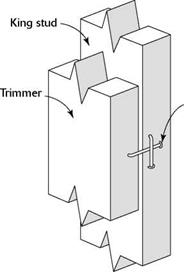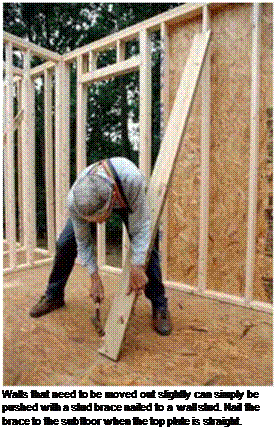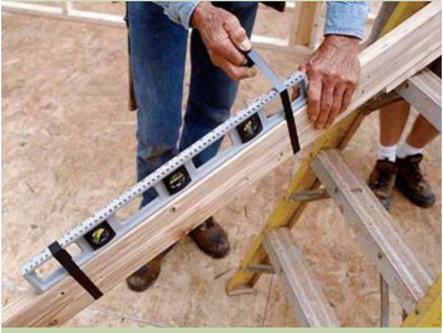MAKING A PLUMB STICK
To plumb walls, you can make a plumb stick from any 2-ft. level and a straight 2×4 stud. Even a battered, inaccurate level can be used. Select the straightest stud you can find and nail a 16-in. 1×2 strip onto each end, letting the strips overhang the stud ends by about 3 in. Use some duct tape to attach a 2-ft. level to the opposite edge of the 2×4 (near the center) and your plumb stick is nearly ready to use (see the photo below).
It’s important to check your plumb stick for accuracy. To do so, hold it vertical and flat against a wall. Keep the bottom end fixed in place as you move the top end back and forth until the bubble is exactly centered in the vial. Make pencil marks on the top and bottom of the wall along the 1x extensions. Now turn the plumb stick side for side—not end for end—so that the level is flat against the wall on the other side of the lines you marked. Carefully line up the extensions with the marks on the plates. If the bubble returns to the exact center of the vial, the plumb stick is accurate. (By the way, you can check the accuracy of any level with this method.)
If the bubble is not centered in the tube, the level needs to be adjusted. Stick a wooden shim, a folded piece of paper, or an 8d nail under one end of the level (between the level and the 2×4), and then check the plumb stick again. Keep adjusting the shim thickness until the bubble is centered both ways.
|
|
1. ![]()
Once the trimmer is plumb, drive an 8d nail into the edge partway and then bend it over, embedding the shank and head in the king stud.
2. ![]()
![MAKING A PLUMB STICK Подпись: To create a straight reference line, stretch a string tightly around 2x spacer blocks positioned at op-posite ends of the wall's top plate. Use another 2x scrap to test for straightness along the top plate. Move the top plate in or out to get the wall straight. [Photo © Larry Haun]](/img/1312/image350_0.gif)

 Clip the first nail by bending a second nail over it. Hammer the clip until both nails are fully embedded in the wood.
Clip the first nail by bending a second nail over it. Hammer the clip until both nails are fully embedded in the wood.

This pair of 8d nails clips one piece of wood next to another. Pairs of nails are frequently used to clip a trimmer stud plumb next to a king stud.
move the top plate out until it’s straight, then secure the bottom of the brace to the floor with two 16d nails. If you are framing on a slab, first nail a 4-ft. 2x flat on the bottom plate at a right angle to the wall, then nail a brace to the wall and to the flat 2x.
Moving a wall in is a little trickier. Try this: Nail a long 1x or 2x under the top plate and against the subfloor. Then place a short 2x under the center of this diagonal brace and bend the brace upward. As the brace flexes upward, the top plate moves in. This works especially well on a wall that is badly out of line.
Make sure you use enough temporary braces as you plumb and straighten the walls to keep every wall in place. Put braces on straight walls as well. Using plenty of braces ensures that the building will be held plumb and straight. Leave all the braces in place until the roof trusses and sheathing have been installed to prevent any frame movement.







Leave a reply